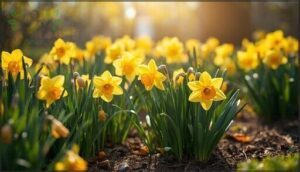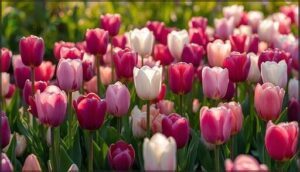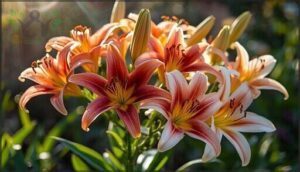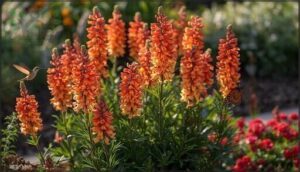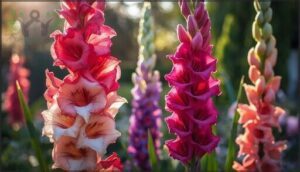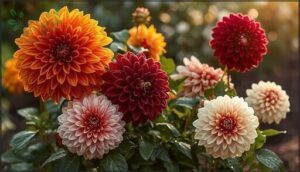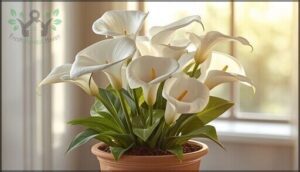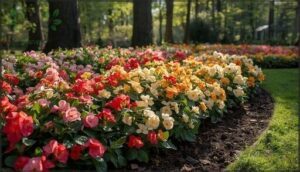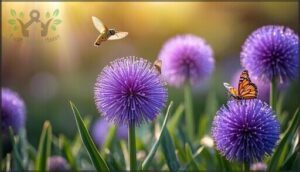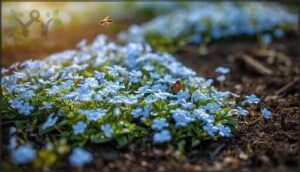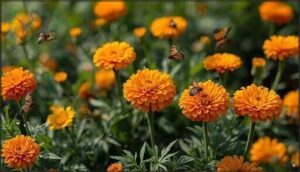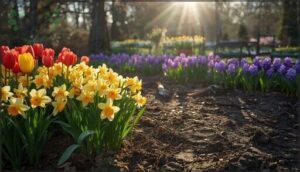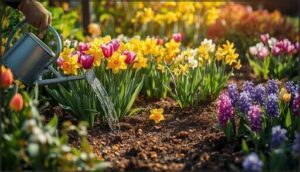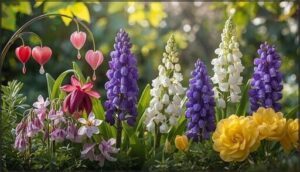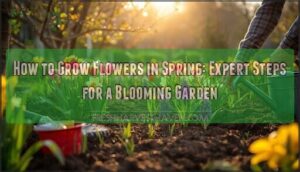This site is supported by our readers. We may earn a commission, at no cost to you, if you purchase through links.
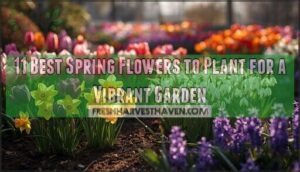
Daffodils might be foolproof for beginners, but tulips demand well-draining soil, and coppertips won’t tolerate shade. When you match each flower’s needs to your garden’s sun exposure, drainage patterns, and climate zone, you create layers of color that unfold week after week.
The best spring flowers aren’t just the prettiest ones—they’re the varieties that flourish in your yard’s unique conditions while attracting pollinators and deer-proofing your beds.
Table Of Contents
- Key Takeaways
- Top Spring Flowers to Plant
- Daffodils: Classic Trumpet-Shaped Blooms
- Tulips: Vibrant Colors for Every Garden
- Asiatic Lilies: Early Season Elegance
- Coppertips: Striking Red, Orange, and Yellow
- Gladiolus: Tall, Frilly, Colorful Stems
- Dahlias: Versatile and Showy Blooms
- Calla Lilies: Elegant Container Choice
- Begonias: Border-Friendly Color
- Lily of The Nile: Pollinator Magnet
- Baby Blue Eyes: Delicate Blue Groundcover
- Calendula: Long-Blooming Annual
- Choosing Flowers for Your Garden
- Planting Spring Flowers: Essential Tips
- Caring for Spring Flower Gardens
- Unique and Specialty Spring Flowers
- Frequently Asked Questions (FAQs)
- Which spring flower lasts the longest?
- What is the most beautiful spring flower?
- What spring flowers are easy to grow?
- When should I start planting flowers for spring?
- What is the prettiest spring flower?
- What is the best flower to plant in May?
- What is the best flower to plant in the spring?
- What are the longest lasting spring flowers?
- Which spring flowers bloom the longest?
- What is the best flower to plant in spring?
- Conclusion
Key Takeaways
- A thriving spring garden depends on matching each flower’s specific needs—like sun exposure, soil drainage, and climate zone—to your yard’s unique conditions, rather than just choosing the prettiest varieties.
- Layering early bloomers like crocus (planted 2-3 inches deep) with mid-season daffodils (4-6 inches) and late bloomers like alliums (6-8 inches) extends your display from February through early summer instead of concentrating all color in one brief window.
- Planting spring bulbs 6-8 weeks before the ground freezes, at depths two to three times their height with pointed ends up, gives roots time to establish before winter and significantly improves bloom success rates.
- Combining perennials that return for up to 20 years with annuals that bloom for 12-16 weeks creates a balanced garden where long-term structure meets flexible seasonal color while reducing maintenance costs and supporting pollinators.
Top Spring Flowers to Plant
Spring brings an explosion of color to your garden, and choosing the right flowers can make all the difference in creating a landscape that truly shines. Whether you’re drawn to classic blooms or bold, unusual varieties, there’s a spring flower that fits your garden’s needs.
Here are eleven exceptional options that will transform your outdoor space from late winter through early summer.
Daffodils: Classic Trumpet-Shaped Blooms
Daffodils bring cheerful trumpet-shaped blooms to your spring garden from late February through May, depending on your zone. You can choose from over 32,000 registered varieties, though only about 10% are commercially available.
Plant bulbs 6 inches deep in fall, ensuring well-drained soil and at least 6–8 hours of sun. These pest-resistant beauties naturalize easily and return year after year.
Knowing your hardiness zone can further specify bloom expectations.
Tulips: Vibrant Colors for Every Garden
Tulips deliver bursts of purple, pink, or white across your spring garden, with over 3,000 registered varieties to explore. Individual blooms last one to three weeks, and you can layer early, mid, and late-season types for six weeks of continuous color in your beds.
Plant bulbs 6–8 inches deep in late October through early December, spacing them 4–6 inches apart in full sun. To guarantee their beauty, provide well-drained soil for best growth.
Asiatic Lilies: Early Season Elegance
Asiatic lilies bring early-summer elegance with upward-facing blooms in shades from white to maroon. You’ll enjoy a five-week bloom period starting in June, with mature bulbs producing up to 20 blossoms per stem.
Plant bulbs deeply in fall, spacing them 11 inches apart in full sun and slightly acidic soil.
These hardy cut flowers thrive in zones 4–9, though lily beetle can pose challenges.
Coppertips: Striking Red, Orange, and Yellow
If you want bold color from late spring through summer, Coppertips deliver fiery red, orange, and yellow blooms on 2–5 foot stems. These disease-resistant spring flowers thrive in zones 6–10, attracting hummingbirds and butterflies while forming impressive clumps in borders and cottage garden designs.
You’ll plant corms 3–6 inches deep in spring after frost, spacing them 6–18 inches apart in full sun and well-drained soil.
Gladiolus: Tall, Frilly, Colorful Stems
Few spring flowers match the dramatic presence of Gladiolus cultivars, whose 3–5 foot stems showcase funnel-shaped blooms in cream, gold, pink, purple, red, and white.
You’ll plant flower bulbs 6–8 inches deep and 6–10 inches apart in well-drained soil, spacing corms for disease resistance.
These planting guidelines support healthy corm yields and blooms 80–90 days later, perfect for spring garden design and extended vase solutions.
Dahlias: Versatile and Showy Blooms
Dahlias stand out among spring flowers with blooms ranging from 2 inches to over 10 inches across, offering garden flower varieties in every hue imaginable. You’ll plant dahlia tubers after your last spring frost, spacing them 12 inches apart in rich, well-drained soil and full sun.
These adaptable plants bloom about 90 days after planting, providing pollinator support and continuous color through fall.
Calla Lilies: Elegant Container Choice
For elegant spring flowers in containers, calla lilies deliver blooms lasting six to twelve weeks, with each flower persisting for several weeks in ideal conditions.
You’ll need well-draining soil and bright, indirect light indoors, or full sun in cooler climates. Water once or twice weekly during active growth, allowing the soil surface to dry between sessions.
These container varieties require overwintering indoors when temperatures drop below 50°F.
Begonias: Border-Friendly Color
Begonias bring a rainbow of color to shaded borders, offering whites, pinks, reds, oranges, and yellows that few shade annuals can match. These spring flowers thrive in container gardening and shade gardens, reaching full coverage in 8 to 12 weeks.
- Plant after the last frost in partial shade with morning sun
- Choose from heights of 8 to 24 inches for defined edges
- Water consistently, keeping soil moist but never soggy
- Pinch off spent flowers every week for continuous blooms
- Amend soil annually with compost for sustained performance
You can create a continuous border by spacing plants 6 to 12 inches apart, depending on the variety’s growth habit.
Lily of The Nile: Pollinator Magnet
If you’re looking for one of the best spring flowers to support pollinators, Lily of the Nile delivers both beauty and function. Its spherical flower heads feature up to 100 tubular blooms, creating abundant nectar production that draws bees, butterflies, and hummingbirds throughout its extended blooming period.
You’ll appreciate its deer resistance, drought tolerance once established, and ability to thrive in zones 8–11, making garden integration simple while delivering real environmental benefits.
Baby Blue Eyes: Delicate Blue Groundcover
Baby Blue Eyes spreads like a soft carpet across your spring garden, reaching just 3 to 6 inches tall with delicate blue flowers dotting its trailing form. Its growth habits make it an ideal ground cover for cool-season displays.
This plant thrives in organically rich, well-drained soil, ensuring strong performance. The peak bloom period stretches from March through June, delivering pollinator value through frequent bee and butterfly visits that support local ecosystems.
Calendula: Long-Blooming Annual
If you want spring flowers that bloom nonstop from late spring to frost, calendula delivers. These low-maintenance annuals reach 8 to 30 inches tall, producing cheerful orange and yellow blooms that attract bees and butterflies for months. You’ll appreciate their pest resistance and medicinal uses in skincare. Plant them 6 to 8 inches apart in well-draining soil with a pH between 5.5 and 7.0.
| Feature | Requirement | Benefit |
|---|---|---|
| Bloom Period | 6-8 weeks to first bloom, continues through fall | Extended color display |
| Soil Preferences | pH 5.5-7.0, well-draining | Encourages continuous flowering |
| Pollinator Attraction | Attracts bees, butterflies, beneficial flies | Aids garden ecosystem |
| Pest Resistance | Repels aphids, beetles | Reduces maintenance needs |
| Medicinal Uses | Wound healing, skin treatments | Functional garden addition |
Choosing Flowers for Your Garden
Choosing the right spring flowers for your garden starts with understanding your growing conditions and what you want to achieve. You’ll need to think about sunlight, soil drainage, and whether you’re planting for one season or many years of blooms.
Let’s look at the key factors that will help you pick flowers that thrive in your space.
Matching Flowers to Sun and Shade
When planning your spring flowers, you need to think about sunlight requirements carefully. Full sun choices like tulips and daffodils require at least six hours of direct light daily for bloom intensity, while shade gardens benefit from primrose and impatiens with their larger leaf morphology.
Match sunny borders with heat-loving coppertips, and reserve part shade spots for begonias. Best placement ensures vibrant, healthy growth.
Selecting for Soil Type and Drainage
Sunlight isn’t the whole story—soil conditions matter just as much. Tulips and daffodils demand well-draining soil, with bulb rot climbing past 35% in heavy clay. For lilies, sandy soil works best, while peonies flourish in rich, organic material.
Amending soils with compost cuts rot by half and boosts bloom success substantially. Match your species selection to soil pH and drainage improvement for strong, healthy flowers.
Picking Deer-Resistant and Pollinator-Friendly Varieties
Beyond soil type, consider wildlife interactions. Deer browsing can wipe out over 50% of non-resistant bulbs early each spring.
That’s why dual-benefit plants like milkweed, coreopsis, and black-eyed Susan shine—they’re best spring flowers that resist deer while drawing pollinators.
Native options like bee balm and allium cut repellent costs by 45% and boost pollinator activity substantially, making garden care simpler year-round.
Annuals Vs. Perennials for Spring Color
Bloom duration matters when weighing annual and perennial flowers for spring color. Annual plants deliver 12–16 weeks of continuous blooms, while perennial plants shine for just 2–4 weeks yearly but return for up to 20 years.
Garden planning improves when you layer both types—perennials anchor your beds with low maintenance needs, and annuals fill gaps with flexible color, balancing cost analysis and environmental impact beautifully.
Best Flowers for Containers and Raised Beds
Container gardening with spring flowers thrives when you match plant heights to space. Violas fit window boxes at 6 inches, while tulips reach 18 inches in deeper pots. Raised bed drainage prevents root rot in ranunculus and dahlias, making them standout choices.
Container soil mixes need fertility for best spring flowers, and bloom time overlap extends color as early tulips fade into late-blooming stock flowers, naturally deterring pests.
Planting Spring Flowers: Essential Tips
Planting spring flowers at the right time and in the right way sets you up for a season full of color. The difference between a garden that thrives and one that struggles often comes down to a few key decisions you make before the first bulb goes in the ground.
Here’s what you need to know to give your spring flowers the best possible start.
When and How to Plant Spring Bulbs
You’ll want to plant spring bulbs 6 to 8 weeks before the soil freezes, usually mid-October in colder zones and November in milder areas. Ideal timing allows roots to establish before winter arrives.
Place bulbs pointed-end up at a depth two to three times their height, spacing large bulbs like daffodils 4 to 6 inches apart. Late planting into January can still work, though success rates drop with time.
Preparing Soil for Optimal Growth
Think of your soil as the foundation for thriving blooms. Start by loosening it to a depth of 12 inches, which improves soil aeration and root development.
Mix in 2 to 3 inches of compost or well-composted manure to boost organic matter and fertility.
Test pH balance every few years, aiming for 6.0 to 7.4, and add perlite or raised beds for drainage improvement in heavy soils.
Planting Depths and Spacing Guidelines
Proper depth and spacing make all the difference in how well your spring flowers perform. Different bulbs have unique variety needs depending on bulb size, soil type, and climate zones.
Follow this planting guide for success:
- Tulips and daffodils: Plant bulbs 6 to 8 inches deep, spacing them 4 to 6 inches apart
- Crocus: Set bulbs 3 to 4 inches deep with 2 to 3 inches between each
- Lilies: Space 8 to 12 inches apart to accommodate their mature size
- Cold regions: Plant deeper—sometimes up to 6 inches—for frost protection
Understanding density effects helps you avoid overcrowding while maximizing your spring display.
Layering Early and Late Bloomers for Extended Color
Layering plant blooms at different depths creates succession blooming from February through early summer. Plant early spring blooming flowers like crocus at 2 to 3 inches, then place late spring blooming flowers such as tulips beneath them at 6 to 8 inches. This vertical layering benefits your garden by extending the bloom season and increasing curb appeal scores by up to 25%.
| Bloom Time | Recommended Flowers | Planting Depth | Spacing | Bloom Duration |
|---|---|---|---|---|
| Early (Feb-Mar) | Crocus, Snowdrops | 2–3 inches | 2–3 inches | 2–3 weeks |
| Mid (Mar-Apr) | Daffodils, Dwarf Tulips | 4–6 inches | 4–6 inches | 3–4 weeks |
| Late (Apr-May) | Alliums, Gladiolus | 6–8 inches | 6–8 inches | 3–5 weeks |
Succession planting maintenance involves bi-weekly deadheading and monthly fertilizing. Species photoperiod needs vary—short-day tulips pair well with long-day alliums—ensuring bloom time overlap extends your display by several weeks.
Caring for Spring Flower Gardens
Once your spring flowers are in the ground, they’ll need the right care to reach their full potential. Proper watering, timely deadheading, and smart fertilizing all play a role in keeping your blooms vibrant throughout the season.
Here’s what you need to know to maintain a healthy, thriving spring garden.
Watering Needs and Frequency
Your spring flowers thrive when you water them about once a week, delivering roughly one inch of moisture to the root zone.
Soil conditions matter: well-drained soil prevents root rot, while moisture retention depends on whether you’re working with clay or sandy ground.
Check soil moisture by feeling the top inch, and adjust your watering needs based on flower type, container versus bed plantings, and seasonal adjustments throughout spring.
Deadheading and Pruning for More Blooms
Once you’ve watered your flowers, deadheading faded flowers keeps them blooming longer and redirects energy to new growth instead of seed production. Snip spent blooms just above the first healthy leaf every 7–10 days during peak season, and you’ll see up to 30% more bloom time in annuals like zinnias and calendula.
Pruning techniques also improve garden health by increasing airflow and reducing disease risk.
Fertilizing and Mulching Strategies
After you’ve tended to spent blooms, fertilizing and mulching become your next power moves for improving soil conditions. Apply balanced NPK fertilizer when growth emerges, then again 6–8 weeks later—this keeps spring flowers thriving. Organic amendments boost your soil microbiome, while inorganic options deliver fast results.
Layer 4 inches of mulch over well-draining soil to lock in moisture and suppress weeds, creating watering synergy that lifts flower counts by 35%.
Dividing and Replanting Perennial Flowers
Once mulch is in place, you’ll want to think about division timing—it keeps perennials healthy long-term. Divide fall-bloomers in spring for 90% survival rates, while summer varieties benefit from early fall splits. This technique’s impact shows immediately:
- Boost flower quality by 30–50% within one season
- Cut fungal diseases by 70% through improved airflow
- Double your garden cost-effectively from single clumps
Proper plant care during propagation maintains vigor for years.
Unique and Specialty Spring Flowers
Beyond the classic tulips and daffodils, you’ll find a world of specialty spring flowers that bring unique textures, fragrances, and forms to your garden.
These distinctive bloomers range from delicate trailing plants perfect for containers to bold shrubs that create stunning focal points in your landscape.
Let’s explore some remarkable options that will set your spring garden apart from the rest.
Pink Queen Diascia Twins Spur: Hanging Basket Favorite
You’ll love Diascia ‘Pink Queen’ if you want nonstop color in your hanging baskets all spring and summer. This compact plant reaches 20 to 25 cm tall and spreads evenly, with pink twin-spur blooms covering the stems from early to late summer.
Deadhead spent flowers regularly to boost bloom production, and feed every two weeks with high-potash fertilizer for best results in your spring gardening displays.
Wallflowers: Fragrant, Easy-to-Grow Choice
Wallflowers bring wonderful fragrance compounds to your spring flower garden, especially when planted in sunny spots near walls or gravel where their habitat preferences are met. These best spring flowers offer chemical defenses against pests, making them wonderfully low-maintenance for growing spring flowers. Here’s what you need to know:
- Plant in well-drained, alkaline to neutral soil
- Apply pruning techniques after blooming for denser growth
- Choose full sun locations for strongest scent
- Appreciate their historical significance in gardens since the 1500s
Bluebells and Forget-Me-Nots: Naturalized Beauty
Bluebells and Forget-Me-Nots create stunning naturalized meadows in your spring flower garden, especially in woodland settings where their habitat preference for moist, partially shaded areas shines.
These best spring flowers carry cultural significance in the UK, where bluebell removal is legally protected.
They excel at pollinator attraction but watch for invasive potential, as Forget-Me-Nots can outcompete natives if conservation status isn’t monitored carefully.
Iris and Peony: Dramatic Focal Points
Iris varieties and Peony cultivars transform your spring flower garden into a breathtaking showcase, with over 300 iris species and 4,000 peony types to choose from. These best spring flowers create dramatic focal points in spring garden design, thriving in well-drained soil with pH between 6.5 and 7.0.
You’ll extend bloom time by layering early and late varieties, while proper fertilization practices guarantee vigorous displays year after year.
Forsythia and Azalea: Shrubs for Spring Color
Forsythia and azalea are flowering shrubs that offer outstanding early spring flowers when most gardens need color most. Forsythia generally blooms in mid-April with bright yellow flowers lasting about 2 weeks, while azaleas bloom from mid-February through May depending on variety.
Here’s what makes these shrubs stand out in spring garden design:
- Bloom time: Forsythia provides one of the earliest nectar sources for pollinators, while azaleas remain in bloom for approximately 2 weeks
- Soil pH: Forsythia tolerates acidic, neutral, and alkaline conditions; azaleas require acidic soil (pH 4.5–6.0)
- Landscape uses: Forsythia grows 2 to 10 feet tall, perfect for hedges and erosion control on slopes
- Disease resistance: Forsythia is especially deer-resistant, while azaleas need routine inspection for lace bugs and spider mites
- Pruning techniques: Remove spent azalea blooms promptly; prune forsythia after flowering to maintain shape
You’ll find forsythia thrives in zones 5–9 with full sun to partial shade, accepting clay, loam, sand, and chalk soils. Azaleas prefer filtered shade with 4–6 hours of morning sun and won’t tolerate poorly drained soils, which increase disease susceptibility over 50%.
Magnolia: Showy Blooms for Larger Spaces
Magnolia trees transform larger spring garden designs with breathtaking blooms that can reach up to 12 inches across, offering white, pink, purple, or yellow petals with an alluring floral fragrance. Different magnolia varieties adapt to various climates, thriving in zones 5–10, while their ecological role aids beetle and fly pollinators through monoecious flowers.
You’ll need well-drained, slightly acidic soil and protection from heavy winds for these flowering trees, which commonly grow 30–80 feet tall depending on the species.
| Feature | Deciduous Types | Evergreen Types |
|---|---|---|
| Bloom Time | Early spring before leaves | Late spring to summer |
| Growth Rate | 1–2 feet annually | 1 foot annually |
| Planting Location | Full sun, rich acidic soil | Full sun to light shade |
Frequently Asked Questions (FAQs)
Which spring flower lasts the longest?
Perennial cultivars like ‘Blushing Bride’ and ‘Dear Dolores’ bloom from spring through fall, lasting months. Pansies and violas offer 8-12 weeks of color.
Bloom time factors include temperature, regional variations, and proper care for extending blooms.
What is the most beautiful spring flower?
Beauty is in the eye of the beholder with regard to spring flowers. Your color preference, bloom shape, fragrance appeal, and cultural symbolism all shape which varieties you’ll find most stunning.
What spring flowers are easy to grow?
Daffodils and crocuses are beginner-friendly flowers with quick germination and excellent climate adaptability. These pest-resistant varieties thrive with minimal garden care, making them low-maintenance blooms perfect for anyone starting spring planting and growing spring flowers easily.
When should I start planting flowers for spring?
Start planting spring bulbs in fall, ideally 6-8 weeks before the ground freezes in your hardiness zones. This timing ensures proper root development and impressive bloom time once frost-free days arrive in spring.
What is the prettiest spring flower?
Prettiest” depends on your taste—tulips offer bold, vibrant color varieties, while daffodils symbolize renewal with their cheerful trumpet blooms.
Garden impact, fragrance appeal, and personal preference make subjective beauty unique to each spring flower lover.
What is the best flower to plant in May?
Picture your garden as a blank canvas awakening in warmer weather—zinnias and marigolds are top May planting choices.
These beginner flowers thrive when soil temperature reaches 65°F, delivering vibrant blooms through summer.
What is the best flower to plant in the spring?
You can’t go wrong with tulips or daffodils for your spring planting. Both varieties offer stunning flower color, tolerate various sun exposure levels, and bloom reliably with minimal maintenance once you match their soil needs.
What are the longest lasting spring flowers?
For maximum bloom duration, you’ll find daffodils and tulips at the top of the list, with flowering seasons stretching several weeks.
Perennial varieties like daylilies offer repeat blooming cycles, while alliums provide remarkable vase longevity.
Which spring flowers bloom the longest?
While some flower varieties fade in weeks, perennial flowers like daylilies and coneflowers keep their blooming season going strong for 8-12 weeks, especially when you deadhead spent blooms regularly throughout late spring.
What is the best flower to plant in spring?
You can’t pick just one “best” spring flower—daffodils excel for low maintenance, tulips for garden impact, and crocuses for early bloom time.
Match sunlight preference and soil needs to your conditions when choosing spring flowers.
Conclusion
Think of your spring garden as a succession of dinner guests—you want arrivals staggered, not everyone crowding the doorway at once. By layering early daffodils with mid-season tulips and late-blooming dahlias, you’ll enjoy uninterrupted color from thaw to summer.
The best spring flowers to plant aren’t just beautiful; they’re matched to your soil, sun, and schedule. Choose wisely, plant with intention, and your garden will reward you with months of vibrant blooms.
- https://todayshomeowner.com/lawn-garden/guides/most-popular-spring-flower-by-state/
- https://www.brecks.com/blogs/blog-post/most-popular-flowers
- https://lgrmag.com/article/google-data-reveals-top-flowers-for-2025/
- https://www.homesandgardens.com/gardens/fastest-growing-flowers-to-plant-spring
- https://thekokorogarden.com/blog/2024/1/1/great-spring-flowers-for-small-scale-flower-farms

